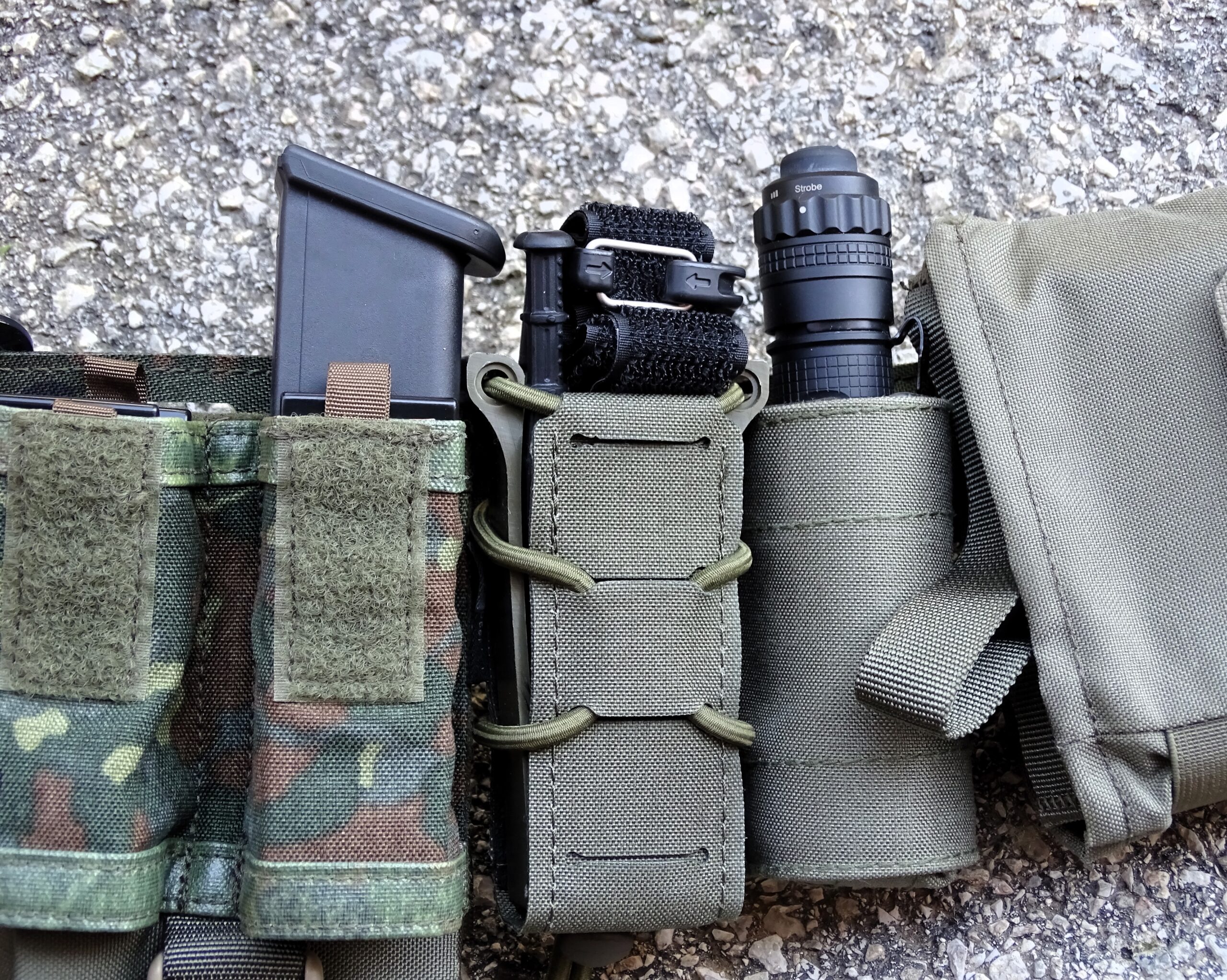Hol Dir den wöchentlichen SPARTANAT-Newsletter.
Dein Bonus: das gratis E-Book von SPARTANAT.

REVIEW: Everyday Carry Tourniquet (ETQ) von SNAKESTAFF SYSTEMS
Es gibt zurzeit viele Tourniquets verschiedenster Hersteller auf dem Markt. Manche dieser Tourniquets werden in speziellen Taschen an Einsatzgürteln, Chest Rigs oder Plattenträger mitgeführt.
Das Everyday Carry Tourniquet (ETQ) der US-amerikanischen Firma SNAKESTAFF SYSTEMS hat ein kompaktes Tourniquet entwickelt, das jederzeit mitgeführt werden kann. SPARTANAT hat sich dieses Abbindesystem genauer angeschaut.
Spezifikation

Das ETQ hat eine Länge vom 95,25 cm und eine Breite von 2,54 cm. Das Gewicht von diesem Tourniquet beträgt 32 Gramm. ETQ ist so konstruiert, dass es sich bis auf einen Durchmesser von 2,54 cm zusammenziehen lässt. Der Vorteil: Es ist anwendbar für Erwachsene, Kinder, Hunde oder andere Lebewesen mit kleinen Gliedmaßen.

Der zweite Vorteil: die kompakte zusammengefaltete Größe entspricht jener eines Glock 19 Magazins. Daher eignet sich ETQ in einer Magazintasche für Pistolen mitgeführt zu werden.

Zum Einsatz kommt das sehr belastbare Nylon Gurtband Typ 13 Class 1a, gewebt in der Farbe Schwarz, gefertigt nach MIL-W-4088. Das Gurtband ist UV beständig und nimmt kaum Feuchtigkeit auf. Auf dem gesamten Gurtband ist Hakenklett angebracht.

Im Vergleich zu den anderen Tourniquets ist ETQ bis zu 65 % kleiner als die anderen Tourniquets (laut Hersteller). Wir haben uns das mit ein paar anderen angeschaut (von links nach rechts): SOF-T, CAT, ETQ, RMT, SICH, SKALA, TROJA Tactical. Hier sieht man deutlich die Größen- und Breitenunterschiede.
Aufbau

Karabinerhaken-Windenschloss: Ankerwinden, die beim Transport angestoßen werden und sich abwickeln, haben sich als tödlich erwiesen. Der Karabinerhaken verriegelt sich automatisch und ist sicherer als ein Klettverschlussband. Der Karabiner dient auch als Befestigungsmöglichkeit und lässt sich an einem Schlüsselring, Rucksack, Gürtelschlaufen oder MOLLE/PALS Schlaufen befestigen.

Strukturierte Ankerwinde: Der strukturierte Aufbau und die Rillen in der Ankerwinde helfen, beim Abbinden auch bei rutschigen Bedingungen einen guten Halt haben.

Chemlight: Das mitgelieferte Chemlight bricht bei der Anwendung auf. Der Ersthelfer erkennt in der Dunkelheit oder bei diffusem Licht, wo das Tourniquet angelegt wurde.

Anleitung: Vereinfachte Anweisung zum Gebrauch sind direkt auf dem ETQ aufgedruckt, für diejenigen, die keine medizinische Erfahrung oder Einweisung in die Anwendung eines Tourniquets haben oder unter Schock stehen. Ein scannbarer QR-Code führt den Anwender zu einem Schritt-für-Schritt-Video-Tutorial.
Anwendung

Das ETQ wird wie jedes andere Tourniquet angelegt. Einmal an einem Oberarm und einmal an einem Oberschenkel. ETQ. Der Druck des Tourniquets soll dazu dienen, bis distal kein Puls mehr tastbar ist und die Blutung steht.

Wir haben das ETQ wirklich ordentlich angezogen.

Leider mussten wir feststellen, dass ein Puls noch ertastbar war. Egal ob am Arm oder Bein. Im Notfall muss ein zweites Tourniquet her. Unsere Testperson hat durchtrainierte 83 kg auf 183 cm und einen Ruhepuls von 43.
Bei größeren, muskulären Armen oder Beinen sind die Anwendungen schon schwieriger. Hinzu kommt noch die Tatsache, dass im Ernstfall die meisten Tourniquets über Bekleidungen angelegt werden.
Vergleich

Zum Vergleich haben wir verschiedene Tourniquets auf eine Styropor-Schwimmnudel angelegt und angezogen. Von links nach rechts: SOF-T Gen.4, CAT Gen.7, ETQ, SICH, SKALA, TROJA Tactical.
Warum? SNAKESTAFF SYSTEMS wirbt mit folgender Aussage (übersetzt): „Hinweis zur TQ-Breite: Der ETQ misst 37,5“ Länge und 1“ Breite. Viele Menschen glauben, dass der Goldstandard TQ breiter ist als er tatsächlich ist. Wenn Sie jedoch ein Exemplar genau untersuchen, werden Sie sehen, dass es nur ein 1-Zoll-Stück Gurtband ist, das die Einschnürung vornimmt. Probieren Sie es selbst aus. Ziehen Sie Ihre TQ über eine Schaumstoffrolle und lassen Sie sie 30 Minuten lang liegen. Kommen Sie zurück und messen Sie die Abdrücke. Sie werden feststellen, dass die Breite nur 1“ beträgt. Eine funktionale Breite von 1“ erfüllt ihre Aufgabe und hat sich seit Jahren bewährt.“
Aus unserer Sicht eine nette Demonstration, nur bei der Anwendung an der Person kam ein anderes Ergebnis heraus. Das ETQ bindet im Gegensatz zu anderen Abbindesysteme nur bedingt vollständig ab.
FAZIT
Das Everyday Carry Tourniquet (ETQ) von SNAKESTAFF SYSTEMS ist klein, kompakt, leicht und lässt sich in einer Magazintasche für Pistolen mit sich führen. Es nimmt nicht viel Platz weg und kann auch in einer Hosentasche verstauen werden. Positiv ist der Karabinerhaken, welcher sehr gut die Ankerwinde sichert. Ein weiterer positiver Punkt ist das Chemlight. Jeder Medic erkennt, wo dieses Tourniquet angebracht ist.
Negativ war bei der Anwendung vom ETQ, dass der Puls noch spürbar war. Im Ernstfall wird ein zweites Abbindesystem benötigt. Inwieweit es wirklich bei Hunden oder Kindern anwendbar ist, konnte nicht in Erfahrung gebracht werden. Ab welchem Alter bei Kindern es angewendet werden kann/darf, konnte auch nicht in Erfahrung gebracht werden.

Die Ankerwinde ist sehr gut gesichert durch den Karabinerhaken. Das restliche Band bekommt man nur sehr schwer über den Karabinerhaken. Das Band vom Tourniquet hält trotz Klettband nicht fest auf seinem Platz, eine Lücke wurde gefunden und schon war das Tourniquet offen. Der Druck vom Tourniquet war so leicht aufzuheben.
Es gibt noch ein ETQ WIDE (Everyday Carry Tourniquet Wide), dies ist nur 12mm breiter als das ETQ, sodass es immer noch kompakt ist, und etwa 35 % kleiner als das Standard-TQ der Industrie.
Eine Anleitung auf dem TQ ist schön und gut, nur im Ernstfall muss jeder Handgriff sitzen. Das Abrufen eines Videos verschwendet Zeit. Und nicht überall ist der Empfang vom Mobilfunk einwandfrei. Jede Sekunde zählt. Stopp the bleed!
Zu erwerben ist das Everyday Carry Tourniquet (ETQ) von SNAKESTAFF SYSTEMS in Europa hier bei B&T AG in der Schweiz für 34,50 CHF.
SNAKESTAFF SYSTEMS im Internet
B&T AG im Internet

„Taktische Medizin“ von Carsten Dombrowski, SPARTANAT Black Book 3, Taschenbuch im Pocket-Format, 136 Seiten, Euro 14,90
SPARTANAT ist das Online-Magazin für Military News, Tactical Life, Gear & Reviews.
Schickt uns eure News: [email protected]
Werbung
Hol Dir den wöchentlichen SPARTANAT-Newsletter.
Dein Bonus: das gratis E-Book von SPARTANAT.


